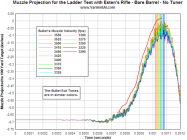@darkangel_r2
I can see the forum is going to jump up and down on you for being inexperienced, and energetic. This is the new normal, so I hope you can get used to it.
There was a time when that was harnessed, corrected, and directed, rather than attacked. Those days are long gone.
Try and carry on with your efforts and take everything with a grain of salt.
The skeptics are not right or wrong, they are just pointing out the pitfalls of where you are headed because some of them have been down this road.
We are all rookies at some point. None of us are born into interior or exterior ballistics. There are some families that are invested in the topics and start their young into shooting early. When one of those folks takes an engineering path, they become dangerous.
Most are not involved in ballistic weapon systems design, physics or engineering. That doesn't mean they don't know what they are talking about when it comes to ballistics and shooting, but they may not speak your language and you don't speak theirs. Try and be diplomatic with your ideas. You need them more than they need you, so take it slow.
If you are interested in discussing or testing a theory, try and bring it on as a theory rather than a bold statement for example. You will attract less flak.
I am assuming you have the background to run FEM and dynamics of some sort and you should follow your interests. This forum is still one of the best places to learn and share your background, but you better learn to have a thick skin and take it slow till you get familiar with the exterior/interior ballistics and shooting experience.
Good luck with your efforts. I hope you stick with it and run it to ground.











